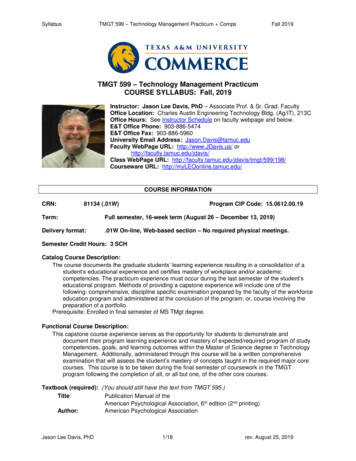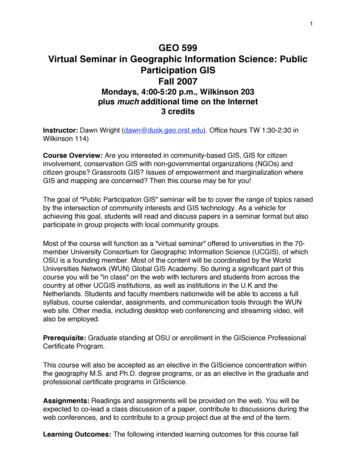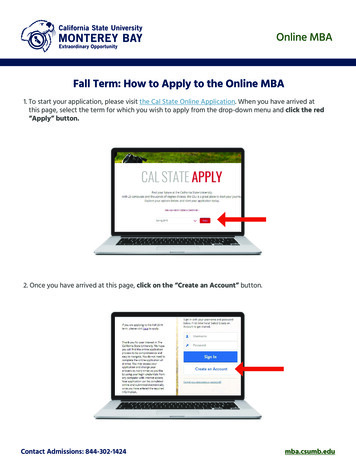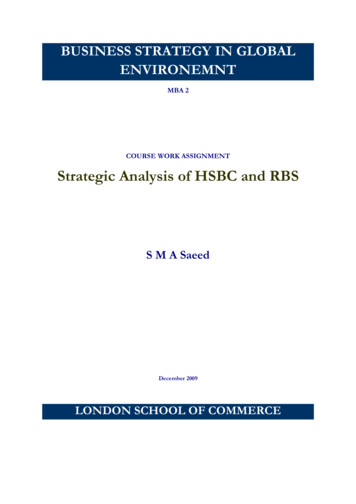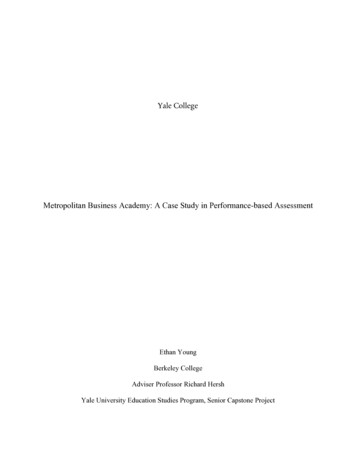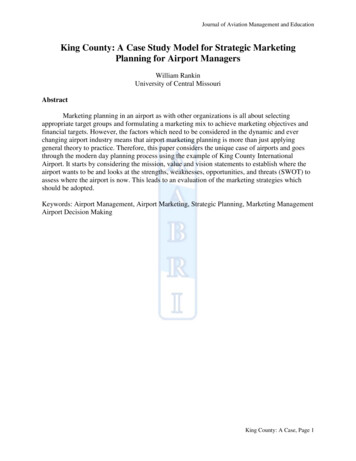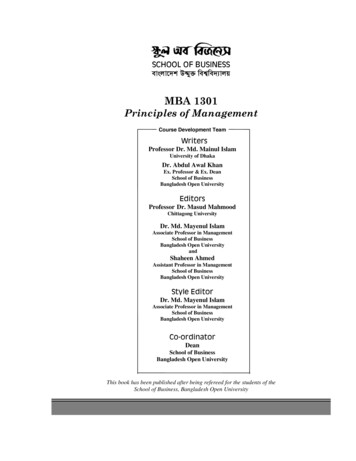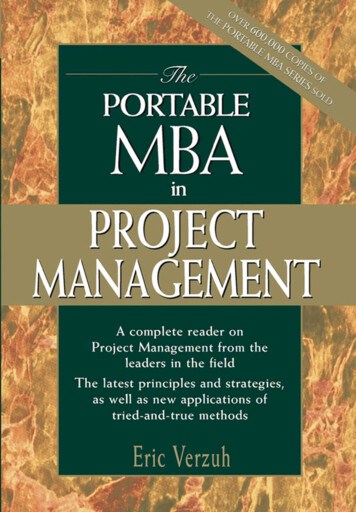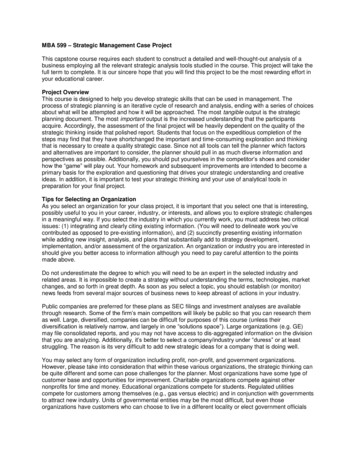
Transcription
MBA 599 – Strategic Management Case ProjectThis capstone course requires each student to construct a detailed and well-thought-out analysis of abusiness employing all the relevant strategic analysis tools studied in the course. This project will take thefull term to complete. It is our sincere hope that you will find this project to be the most rewarding effort inyour educational career.Project OverviewThis course is designed to help you develop strategic skills that can be used in management. Theprocess of strategic planning is an iterative cycle of research and analysis, ending with a series of choicesabout what will be attempted and how it will be approached. The most tangible output is the strategicplanning document. The most important output is the increased understanding that the participantsacquire. Accordingly, the assessment of the final project will be heavily dependent on the quality of thestrategic thinking inside that polished report. Students that focus on the expeditious completion of thesteps may find that they have shortchanged the important and time-consuming exploration and thinkingthat is necessary to create a quality strategic case. Since not all tools can tell the planner which factorsand alternatives are important to consider, the planner should pull in as much diverse information andperspectives as possible. Additionally, you should put yourselves in the competitor’s shoes and considerhow the “game” will play out. Your homework and subsequent improvements are intended to become aprimary basis for the exploration and questioning that drives your strategic understanding and creativeideas. In addition, it is important to test your strategic thinking and your use of analytical tools inpreparation for your final project.Tips for Selecting an OrganizationAs you select an organization for your class project, it is important that you select one that is interesting,possibly useful to you in your career, industry, or interests, and allows you to explore strategic challengesin a meaningful way. If you select the industry in which you currently work, you must address two criticalissues: (1) integrating and clearly citing existing information. (You will need to delineate work you’vecontributed as opposed to pre-existing information), and (2) succinctly presenting existing informationwhile adding new insight, analysis, and plans that substantially add to strategy development,implementation, and/or assessment of the organization. An organization or industry you are interested inshould give you better access to information although you need to pay careful attention to the pointsmade above.Do not underestimate the degree to which you will need to be an expert in the selected industry andrelated areas. It is impossible to create a strategy without understanding the terms, technologies, marketchanges, and so forth in great depth. As soon as you select a topic, you should establish (or monitor)news feeds from several major sources of business news to keep abreast of actions in your industry.Public companies are preferred for these plans as SEC filings and investment analyses are availablethrough research. Some of the firm’s main competitors will likely be public so that you can research themas well. Large, diversified, companies can be difficult for purposes of this course (unless theirdiversification is relatively narrow, and largely in one “solutions space”). Large organizations (e.g. GE)may file consolidated reports, and you may not have access to dis-aggregated information on the divisionthat you are analyzing. Additionally, it’s better to select a company/industry under “duress” or at leaststruggling. The reason is its very difficult to add new strategic ideas for a company that is doing well.You may select any form of organization including profit, non-profit, and government organizations.However, please take into consideration that within these various organizations, the strategic thinking canbe quite different and some can pose challenges for the planner. Most organizations have some type ofcustomer base and opportunities for improvement. Charitable organizations compete against othernonprofits for time and money. Educational organizations compete for students. Regulated utilitiescompete for customers among themselves (e.g., gas versus electric) and in conjunction with governmentsto attract new industry. Units of governmental entities may be the most difficult, but even thoseorganizations have customers who can choose to live in a different locality or elect government officials
willing to change the status quo. If you are undecided, medium or small-size competitive, profit-orientedorganizations may provide the best platform for applying course concepts.Project DeliverablesPhase 1 – Modules 1-3 (Outline for Strategic Management Case) Introduction of the company (limit to a maximum of three single-spaced pages).o Description of the firm and its productso Company history (brief history, critical events, competitors, leadership), including strategicelements of its historyo Vision and mission statemento Assessment of mission and visionExternal assessmento EFE and CPM with strategic implicationso Analysis of competitive position, opportunities, and threatsInternal assessmento IFE with strategic implicationso Financial ratio analysis with key conclusions and implications for strategic choiceo Overall analysis of internal capabilities and implications for your strategic decisionsModule 1:Select company and secure instructor approval. Once approved, create plan outline, insertcurrent mission and vision.Module 2:Complete an EFE and CPM for your company (including analysis and conclusions) and insertin your working draft which you will hold until you submit Phase 1 during Module 3. .Module 3:Complete an IFE and calculate financial ratios (including analysis and conclusions) for yourcompany and insert in your plan to submit at the end of Module 3.Submit all of Phase 1 to the Assignment box no later than Sunday 11:59 PM EST/EST of Module 3.(This Assignment box basket may be linked to Turnitin.)Phase 2 – Modules 4-6 (includes revisions to Phase 1 based on the instructor's feedback) Internal assessment (continued from Phase 1—include IFE and financial ratios)o Current strategy (brief description of the firm’s current strategies), including current use oftechnologyo SWOT matrix with strategic implications for the companyo BCG matrix with strategic implications for the companyo Space or other matrices with strategic implications for the companyo Possible strategic alternativeso Evaluation of current organizational structureo Recommendation changes (if needed) to the structure, culture (including values), processes,rewards, or technologyModule 4:Integrate instructor feedback from Phase 1.Module 5:Develop SWOT, BCG, SPACE, and IE matrices with strategic implications for the company.Module 6:Develop alternative strategies for your company with strengths and weaknesses of each.Submit all of Phase 2 to the Assignment box no later than Sunday 11:59 PM EST/EST of Module 6.(This Assignment box basket may be linked to Turnitin.)
Phase 3 – Modules 7-8 (includes revisions to Phase 2 based on the instructor's feedback) Strategic analysis, choices, impact, and measuremento Product-positioning mapo Evaluation of strategies and objectives to achieve most favorable market positiono Description of how you would implement your strategieso Milestones (steps for each major initiative with their timelineso Specific results you want to achieve including market, financial, and product or service goalso Financial projection (minimum three years)o Presentation with audio – see belowo Executive summary – see belowPresentation with audioThe final submission for your project includes developing a PowerPoint presentation withembedded audio files. Each slide must contain an audio file in which you offer insight to thematerial in the slide and key points the professor should take away from the visualinformation in the PowerPoint. You should minimize repeating points made in the slide otherthan emphasizing important components. To put this simply, please do not read the slidesverbatim but make sure to add value to what is presented on the slide to improve theunderstanding of your work. The presentation with audio is a significant component of thefinal submission, so please makes sure to offer your best work, speak clearly, emphasize thestrategic implications of your work, and engage the viewer.Executive summary (compiled with concise and critical elements from the detailed work)While done as a last step, this goes in front of the report, after the index. A final and allencompassing analysis is presented, along with the recommendations that you would maketo the firm’s board of directors. This includes identifying what you recommend, and brieflyoutlining alternatives considered, key implementation steps, and the impact of theimplementation on the company’s performance and competitive position.Module 7:Develop a product-positioning map with strategic implications for the company.Conduct final evaluation of alternative strategies and detailed description of selected strategy.Module 8:Develop detailed implementation and assessment plan.Complete financial projections.Create presentation with audio.Complete the executive summary and insert into the plan.Complete all editing, verification, and citing of all sources, and insert graphs and illustrations.Submit all of Phase 3 to the Assignment box no later than Thursday 11:59 PM EST/EST of Module 8.(This Assignment box basket may be linked to Turnitin.)Project SubmissionPlease do not jeopardize completing your MBA! Before you begin, read the plagiarism policy in thesyllabus and catalogue. There is zero tolerance for plagiarism in this course. Any case of plagiarism willbe taken seriously. All assignments will be submitted to Turnitin and be subject to additional validation bythe professor. Work from prior classes cannot be used in this course without prior, written permission fromthe professor.Project EvaluationAll sections of the plan are evaluated based on:1. Correctness and completeness: models/matrices used in the case are reasonably sound/accurateand thorough.2. Strategic analysis and conclusions: points made are insightful and clear with relative importancedistinguished (not just a “rehash” of the facts).
3. Logical sequence and continuity of writing: the reader can seamlessly move from paragraph toparagraph or section without losing his or her train of thought.4. Grammar, punctuation, spelling, sentence structure are at the graduate level.5. External sources: the ability to integrate and interpret external sources of information. As acapstone class, the external research is extensive, relevant, and informative to the company’sdirection, its competition, industry, and choices.6. Language: the effective use of standard business terms especially those emphasized in the Davidtext and prior business courses.See the full grading rubric at the conclusion of this document.Tips for Completing the ProjectYou should expect to build up a large mass of analyses before you can put together a coherent case. Inthe end, a great case will always look “simple” relative to the countless hours going down many differentpaths in order to build understanding. The volume of material generated can distract from the creativepart of the process. The following suggestions are designed to serve as a reminder for things notidentified distinctly in the assignments, the syllabus, or the textbook Plan preparation guidelines.1. Company and industry backgroundUse your own judgment to determine the amount of background to include. Over-detailedcompany history is usually irrelevant and rarely improves the report. On the other hand, a historyof strategic moves and competitive reactions might be very illustrative. Decide what to includebased on whether that information is important to understanding the future environment andstrategic choices. Market share, financial strength, brand image, and the like are always relevantstrategically.2. Address uncertaintyIn your strategic analysis, make sure to state any assumptions related to your business. If youbelieve there is going to be high risk, describe contingency plans or alternate scenarios.3. Discuss the things that create organizational culture and behavior necessary to supportthe strategya. What operational and motivational processes create the culture (acting your way into a newway of thinking, identity orientation, incentives, etc.)?b. What organizational structure fits the mission/vision, the operational approach, and the needfor adaptability or stability?c. Make sure to delineate your ethics standards including values the company lives by.4. Boston Consulting Group (BCG) and internal/external (IE) matricesSome of you may think that the BCG and IE matrices are not relevant to your project since yourorganization only reports one business segment. First, these exhibits are important to thinkthrough and are required even if they only have one product line. Second, there are often moresegments in any organization than meets the eye. The reason to break up the business intocomponent parts is to shed some light on the strategic positioning and future potential. Askyourself, are there segments that behave differently (different customers, competitors, growthrates, success factors, etc.)? You can be sure that Wal-Mart is looking at grocery, clothing,pharmacy, electronics, toys, garden, and automotive all separately, and possibly even separatingseasonal items. For purposes of this class, approximations can be used whenever necessary toseparate a subunit. Pushing the analysis down to a more detailed level forces you to recognizewhat you know and what you do not know. I am more concerned with strategic thinking than withavailability of detailed data. You can put estimated numbers in your plans as long as a note isadded explaining the basis, reasoning, and level of uncertainty.5. ImplementationYour implementation strategy must show how it is aligned with your strategic objectives. Thestrategic-level implementation questions are mainly resource-related (where the money/people
come from) and timing issues (when are initiatives expected to happen). In addition, if there issomething specific mentioned in the analysis (e.g., a trend, a weakness, concerns about thecompetitive response) that affects implementation, then you need to include the relevant part ofthe implementation approach mentioned as part of the strategy. If there is not anything notable inthese kinds of areas, then specific content is not required in the report.6. Overall assessment of the strategyAs you prepare your strategies, it will be helpful to review Rumelt’s four criteria:a. Consistencyi. Strategy should not present inconsistent goals and policies.ii. All of the pieces of your overall strategic approach should be aligned.b. Consonancei. Strategy should examine sets of trends.c. Feasibilityd. Advantagei. Strategy should include creation or maintenance of competitive advantage.7. SourcesFollow APA style guide to write the case. Cite within the body of your case and include areference list. This is particularly true for any source data that will come from financial reports andcorporate websites.Project Grading (See detailed grading rubric at end of these instructions)Eighty percent (80%) of the course grade will be determined based on the Strategic Management Caseas distributed below:1. Phase 1: Proposal and initial analysis (20% of course grade)2. Phase 2: Substantive draft (20% of course grade)3. Phase 3: Final Case (40% of course grade)Example Outline and Structure for the Strategic Plan (Headings)The outline below is an example and should be modified to adapt to your company. The primary headingsare good ways to organize your work into logical sections (e.g., internal analysis, external analysis, etc.).Cover PageIndexExecutive OverviewIntroduction of the CompanyDescription of the firmCompany historyVision and mission statementStrategic elements of the historyOverall assessmentExternal AssessmentEFE and CPMAnalysis of competitive position, opportunities, and threatsInternal AssessmentFinancial ratio analysisIFEAnalysis of internal capabilities and implications for your strategic decisions to followCurrent strategy, including current use of technology
Possible alternativesSWOT matrixBCG matrixSpace or other matricesDescription of core values you would use to create the desired cultureEvaluation of current organizational structureRecommendation changes (if needed) to the structure, processes, rewards, or technologyStrategic Analysis, Choices, Impact, and MeasurementProduct-positioning mapEvaluation of strategies and objectives to achieve most favorable market positionDescription of how you would implement your strategiesMilestones (steps for each major initiative with their timelinesSpecific results you want to achieve including market, financial, and product or service goals, andhow and when they will be measuredFinancial projection (minimum three years)Presentation with audio
15-1617-1819-200 1515-1617-1819-20Exceptional 15Proficient0BasicMBA 599.01; MBA 599.04; & MBA 599.06NoviceComponentNo submissionGrading RubricProgram Outcome #1 - Apply key knowledge of corebusiness management functions (management,marketing, accounting, and finance)Description of the firm (brief history, critical strategic events,competitors, leadership, etc.). If there are any generalsituational assumptions or limitations on the scope of theanalysis, these should also be specified here. This sectionshould be limited to a maximum of five pages. Note: Somestudents may select a new business venture for a firm theywould seriously consider starting. For these students, thissection will focus on a research based history, critical strategicevents, emerging competition, and industry leaders.MBA 599.02 & MBA 599.03Outcome #5 - Recognize and effectively analyze complexbusiness problems using critical thinking skillsThe strategic analysis of the firm. The results of each strategictool are presented along with a discussion of importance andimplications. Also required are sections for financial analysisand assumptions, although the specific contents of thesesections may vary considerably. Discussion on external opportunities and threats Discussion on internal strength and weaknesses Subsection for each model (CPM, EFE, IFE, SWOT,SPACE, BCG, IE, QSPM) on the firm, analysis andstrategic implications Specific strategic strategies and long-term objectives
MBA 599.07 & MBA 599.090 1515-1617-1819-200 1515-1617-1819-200 77-8910Outcome #6 - Make ethical business decisions within thecontext of a diverse set of stakeholders and in aneconomically responsible mannerFinancial strategic assessment. This section should integratethe findings from all of the analytical exercises employed inPhase 2 (strategic analysis of the firm). A final and allencompassing analysis is presented, along withrecommendations that you would make to the firm’s board ofdirectors. This would include identifying what you would andwould not do, and outlining any relevant alternate scenarioplans or contingency plans. Be sure to address any potentialcompetitive reaction. Revenue, cost, and financial implications. (Note: youshould prepare five-year financial statements) Project timeline, key milestones, and specific annualobjectives Method for reviewing and evaluating strategyimplementationMBA 599.10Outcome #4 - Apply widely used technology tomanagement issuesThe plan should discuss current use of technology,consideration of any new technology solutions or potential forimprovements in the use of technology.Internal Assessment Current Strategy (brief description of the firm’scurrent strategies), be sure to discuss current use oftechnology Recommendation changes (if nee
MBA 599 – Strategic Management Case Project This capstone course requires each student to construct a detailed and well-thought-out analysis of a business employing all the relevant strategic analysis tools studied in the
